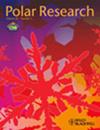Missing and misidentified museum specimens hinder long-term monitoring: a case study of shell-bearing gastropods from the Kola Meridian transect, Barents Sea
IF 1.3
4区 地球科学
Q3 ECOLOGY
引用次数: 0
Abstract
The consequences of global change cannot be estimated without long-term monitoring programmes. The Kola Meridian transect, along 33°30’E, in the Barents Sea is the longest term monitoring area in the Arctic. Regular (usually annual) hydrobiological benthic surveys along that transect have been performed since 1899. Materials stored in museum collections remain the main source of the faunistic information obtained during the surveys, while only a minor part of these data was published. We reexamined all samples of shell-bearing gastropods from the Kola Meridian stored at the Zoological Institute of the Russian Academy of Sciences and at Saint Petersburg State University. We found only 159 museum lots from 73 samples, which constitute a very small portion of the total material collected along the transect. Approximately one-third of them (54 lots) was misidentified or includes individuals that cannot be identified at species level. The species composition revealed by museum materials differs substantially from published checklists. Majority of the studied samples (40) were collected during 1899–1920. However, the extant collections do not provide a reliable baseline for the Kola Meridian. We propose that the storage of zoological material in public collections should be considered as an essential part of long-term monitoring programmes.博物馆标本的丢失和错误鉴定阻碍了长期监测:巴伦支海科拉子午线样带带壳腹足类的案例研究
没有长期监测方案,就无法估计全球变化的后果。位于巴伦支海沿33°30′e的科拉子午线样带是北极最长的监测区域。自1899年以来,沿着该样带进行了定期(通常是每年一次)的底栖生物调查。博物馆收藏的材料仍然是调查中获得的动物信息的主要来源,而这些数据中只有一小部分被公布。我们重新检查了存放在俄罗斯科学院动物研究所和圣彼得堡国立大学的科拉子午线的所有带壳腹足类样本。我们从73个样本中只发现了159个博物馆藏品,这只占沿样带收集的全部材料的很小一部分。其中约三分之一(54批)被错误识别或包含无法在物种水平上识别的个体。博物馆资料显示的物种组成与公布的清单有很大的不同。大多数研究样本(40个)是在1899-1920年间收集的。然而,现存的收集不能为科拉子午线提供可靠的基线。我们建议将公共收藏的动物材料作为长期监测计划的重要组成部分。
本文章由计算机程序翻译,如有差异,请以英文原文为准。
求助全文
约1分钟内获得全文
求助全文
来源期刊

Polar Research
地学-地球科学综合
CiteScore
3.20
自引率
5.30%
发文量
22
审稿时长
>12 weeks
期刊介绍:
Since 1982, Polar Research has been the international, peer-reviewed journal of the Norwegian Polar Institute, Norway''s central institution for research, environmental monitoring and mapping of the polar regions. Aiming to promote the exchange of scientific knowledge about the Arctic and Antarctic across disciplinary boundaries, Polar Research serves an international community of researchers and managers. As an open-access journal, Polar Research makes its contents freely available to the general public.
Original primary research papers comprise the mainstay of Polar Research. Review articles, brief research notes, letters to the editor and book reviews are also included. Special issues are published from time to time.
The scope of Polar Research encompasses research in all scientific disciplines relevant to the polar regions. These include, but are not limited to, the subfields of biology, ecology, geology, oceanography, glaciology and atmospheric science. Submissions from the social sciences and those focusing on polar management and policy issues are welcome. Contributions about Antarctica are particularly encouraged.
 求助内容:
求助内容: 应助结果提醒方式:
应助结果提醒方式:


